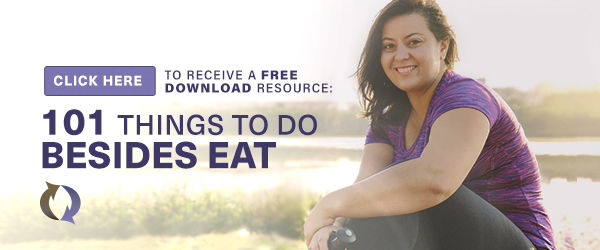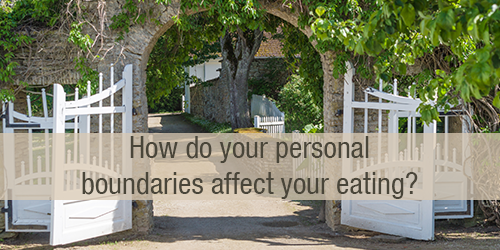Your personal boundaries and your eating are often closely related. Are your personal boundaries rigid and impossible to get through? Or are your boundaries wide open, allowing anyone and anything in? Or are they flexible, allowing you to adapt while respecting your personal needs?
What are boundaries?
Think of your personal boundaries as a fence around who you are. Like a fence, your boundaries determine who and what can get through.
Your boundaries emerge from your beliefs about what you deserve and don’t deserve, what you want and need, and what you like and dislike. Your sense of the importance of your personal rights, especially your right to take care of yourself, will determine the type of boundaries you create around yourself.
Your boundaries have a major effect on your relationships with other people because they determine where you stop and where they begin. Boundaries also affect how you take care of yourself by determining what you will accept in how people interact with you. When you value, trust, and listen to yourself, you are able to maintain healthy boundaries with others—and leave relationships that aren’t healthy for you.
Let’s take a look a closer look at boundaries and how your boundaries affect your eating.
Permeable Boundaries
 Just as it sounds, permeable boundaries let everything in. If you don’t trust yourself to know what is best for you, your boundaries will be very permeable.
Just as it sounds, permeable boundaries let everything in. If you don’t trust yourself to know what is best for you, your boundaries will be very permeable.
- You may determine your worth and value based on what other people think (or seem to think).
- You may look around to determine what others expect of you and attempt to please them to avoid the risk of disapproval, rejection, or abandonment.
- You may have difficulty holding on to your convictions in the presence of others who disagree.
- You may give too much information to people who haven’t earned the right to have it.
Permeable boundaries and eating
In terms of food and eating, permeable boundaries may look like this:
- You may avoid certain people or events because of your feelings about your size or the fear that others will judge you negatively.
- In public you may eat what you think other people expect you to or let other people decide what you are “allowed” to eat because you don’t respect your own right to eat what you want. Then when you’re alone, you secretly overeat what you want.
- You may eat when you aren’t hungry or eat food you don’t really want to please others or avoid conflict.
- You may eat to stuff your feelings, thoughts, or opinions.
- You may eat to spite others who try to control your eating.
- You may try any diet that promises to solve your problems.
Rigid Boundaries
 Rigid boundaries are too thick and inflexible, so you have difficulty letting information and people in—and out.
Rigid boundaries are too thick and inflexible, so you have difficulty letting information and people in—and out.
- When your boundaries are rigid, you may be firmly attached to your position and expect other people to accommodate you.
- You may have difficulty accepting responsibility, feedback, or criticism.
- You may exhibit black and white, right or wrong, and good versus bad thinking.
- It may be difficult for you to consider options other than what you already believe.
- You may be overly protective of your boundaries, guarded, and have difficulty showing vulnerability.
Rigid boundaries and eating
Examples of how rigid boundaries and eating are related:
- You may struggle with special events, vacations, and other situations because you have difficulty adapting when you are not in direct control.
- You may be convinced that you should try to follow strict diet rules to manage your eating, even though this hasn’t worked for you in the past.
- You may use guilt or manipulation to control someone else’s eating or exercise.
- You may be stuck in your Overeating and Restrictive Eating Cycles because you have difficulty accepting that there are other options or unexamined issues driving your behaviors.
- You may have difficulty asking for help because you don’t trust others or want to appear vulnerable.
Flexible Boundaries
 Flexible boundaries are clear but adaptable when the situation requires it. It’s like having a gate you are in charge of!
Flexible boundaries are clear but adaptable when the situation requires it. It’s like having a gate you are in charge of!
- When your boundaries are flexible, you have a strong sense of self so you value, trust, and listen to yourself.
- Your boundaries are expressive of your true self so they are authentic and comfortable.
- You’re willing to take into consideration the possibility of a different perspective or new information but you’re able to hold onto your beliefs even when others disagree.
- You’re open and able to adapt to different circumstances depending on what is most effective for you.
Flexible boundaries and eating
Take a look at flexible boundaries and eating:
- You’re able to eat in public without guilt or shame.
- When you overeat, you’re still able to accept yourself and learn from your mistakes.
- You’re able to use new information and learn new strategies that will help you manage your eating more effectively.
- You express your thoughts and feelings instead of using food to escape them.
- You don’t postpone living your life.
This article is updated from a previous version.
If you enjoyed this article, here are three more to help you:
Mindful Relationships Part 2: Assertive Communication
Is Perfectionism Eating You Up?
How to Make Sense of Your Eating Issues



Comments are closed.